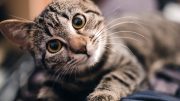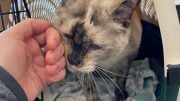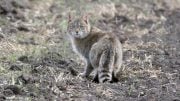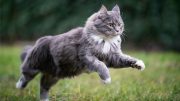
Wildlife conservation researchers identify five types of cat owners.
Cat owners fall into five categories in terms of their attitudes to their pets’ roaming and hunting, according to a new study.
University of Exeter researchers surveyed UK cat owners and found they ranged from “conscientious caretakers” concerned about cats’ impact on wildlife and who feel some responsibility, to “freedom defenders” who opposed restrictions on cat behavior altogether.
“Concerned protectors” focussed on cat safety, “tolerant guardians” disliked their cats hunting but tended to accept it, and “laissez-faire landlords” were largely unaware of any issues around cats roaming and hunting.
Conservation organizations have long been concerned about the numbers of animals caught by the UK’s large population of domestic cats.
Most pet cats kill very few wild animals, if any, but with a population of around 10 million cats, the numbers of birds, small mammals, and reptiles killed can accumulate.
Apart from their role as “mousers,” most owners find the dead animals brought home an unpleasant reminder of their pet’s wilder side.
Addressing this problem has been difficult because of disagreements between people prioritizing cat welfare and those focusing on wildlife conservation.
The Exeter team’s ongoing research project “Cats, Cat Owners, and Wildlife” aims to find a conservation win-win, by identifying ways of owners managing their cats that benefit the cats as well as reducing wildlife killing.
This research is a step towards understanding how cat owners view their cats and how best to manage them.
The researchers say their findings demonstrate the need for diverse management strategies that reflect the differing perspectives of cat owners.
“Although we found a range of views, most UK cat owners valued outdoor access for their cats and opposed the idea of keeping them inside to prevent hunting,” said lead author Dr Sarah Crowley, of the University of Exeter’s Environment and Sustainability Institute in Cornwall.
“Cat confinement policies are therefore unlikely to find support among owners in the UK.
“However, only one of the owner types viewed hunting as a positive, suggesting the rest might be interested in reducing it by some means.
“To be most effective, efforts to reduce hunting must be compatible with owners’ diverse circumstances.”
Suggested measures to reduce hunting success include fitting cats with brightly colored “BirdsBeSafe” collar covers. Many owners also fit their cats with bells.
The research team is now examining the effectiveness of these and other new measures and how owners feel about them, with a view to offering different solutions.
“This latest research we have funded reveals the incredibly diverse perspectives amongst cat owners in regard to their pets’ hunting behavior,” said Tom Streeter, Chairman of SongBird Survival.
“If nature is to ‘win’ and endangered species thrive, a pragmatic approach is needed whereby cat owners’ views are considered as part of wider conservation strategies.
“The study highlights the urgent need for cat owners and conservationists to work together to find tailored solutions that are cheap, easy to implement, and have a positive effect on wildlife and bird populations across the UK.”
iCatCare’s Head of Cat Advocacy, Dr. Sarah Ellis, said: “The finding that many UK cat owners actually care a great deal about wildlife conservation and their cats’ impact on it, suggests that some owners are receptive to employing cat-friendly ways of reducing hunting.
“The right interventions could improve wildlife conservation efforts, maintain good cat mental-wellbeing, and at the same time improve the cat-human relationship.
“This would be especially true for ‘tolerant guardians’ and ‘conscientious caretakers’, by reducing the internal conflict of loving an animal that often hunts other animals they also care about.”
The study included 56 cat owners, some from rural parts of the UK (mostly in south-west England) and some from urban areas (Bristol and Manchester).
The paper, published in the journal Frontiers in Ecology and the Environment, is entitled: “Diverse perspectives of cat owners indicate barriers to and opportunities for managing cat predation of wildlife.”
Alongside the detailed research survey, the researchers have created a simple quiz so cat owners can find out which category bests describes them.
Reference: “Diverse perspectives of cat owners indicate barriers to and opportunities for managing cat predation of wildlife” by Sarah L Crowley, Martina Cecchetti and Robbie A McDonald, 3 September 2020, Frontiers in Ecology and the Environment.
DOI: 10.1002/fee.2254









Yet another example of poor research apparently conducted to provide propaganda under the guise of “science.” A key tell of the ideological motivation is that the role of cats is depicted as having only negative, or at best, benign influences. That is, totally overlooked is the role of cats in reducing unwanted and destructive rodents, the original reason for domesticating cats. Further, the unstated assumption is that in the absence of cats, desirable species such as song birds would no longer be killed. That is overlooking the obvious fact that extra food available for wild predators will allow the predator population to expand to take advantage of the small animals not taken by cats. Were this an honest, objective study on the role of cats, it would inventory ALL predators of small animals and determine the percentage of each type of animal taken by each of the predators, with observations on the ability of one predator to proxy for another. In short, the authors have made a statement that cats take an undesirable number of small animals, but they have not made a case for the claim. Thus, their categorization of owners is little more than fanciful speculation about how owners have a responsibility for what is probably an ‘non-problem.’ If the reader feels that “One bird killed is one bird too many,” then consider the role of high-rise buildings and modern wind mills.” If they were removed, nothing would take their place.